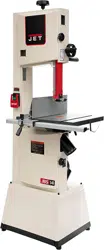Loading ...
Loading ...
Loading ...

18
Slide the bar of the miter gauge into the end of the
slot on the table.
The right hand should hold the workpiece steady
against the miter gauge, while the left hand pushes
the miter gauge past the blade, as shown in Figure
9-3.
Do not use the fence in conjunction with the miter
gauge. The offcut of the workpiece must not be
constrained during or after the cutting process.
Using the fence in conjunction
with the miter gauge can cause binding and
possible damage to the blade.
Figure 9-3: crosscutting
9.4 Resawing
Resawing is the process of slicing stock to reduce
its thickness, or to produce boards that are thinner
than the original workpiece. See Figure 9-4.
The ideal blade for resawing is the widest one the
machine can handle, as the wider the blade the
better it can hold a straight line.
Figure 9-4: resawing
When resawing thin stock, use a push block, push
stick, or similar device to keep your hands away
from the blade.
9.5 Blade lead
Blade lead, or drift, is when the blade begins to
wander off the cutting line even when the band saw
fence is being used. Figure 9-5 shows an example
of blade lead. It is more common with small, narrow
blades, and is almost always attributable to poor
blade quality, or lack of proper adjustments. Inspect
the band saw for the following:
Fence not parallel to miter slot and blade.
Blade not tensioned correctly.
Blade is dull.
Teeth have excessive “set” on one side of
blade.
Workpiece being fed too quickly.
Figure 9-5: blade lead
9.6 Saw blade selection
Using the proper blade for the job will increase the
operating efficiency of your band saw, help reduce
necessary saw maintenance, and improve your
productivity. Thus, it is important to follow certain
guidelines when selecting a saw blade.
Here are factors to consider when selecting a blade:
The type of material you will be cutting.
The thickness of the material.
The features of the material, such as bends
or curves with small radii.
These factors are important because they involve
basic concepts of saw blade design. There are five
(5) blade features that are normally changed to meet
certain sawing requirements. They are:
1. width
2. pitch (number of teeth per inch)
3. tooth form (or shape)
4. the "set" of the teeth
5. the blade material itself.
Loading ...
Loading ...
Loading ...
